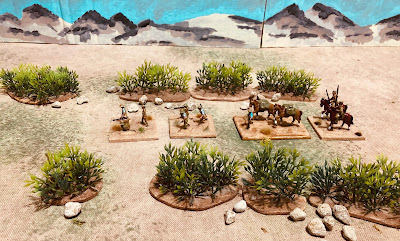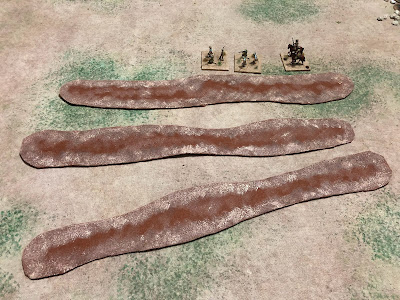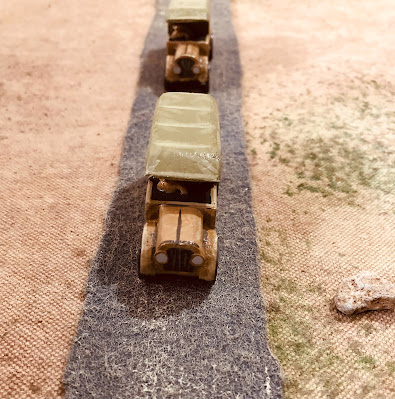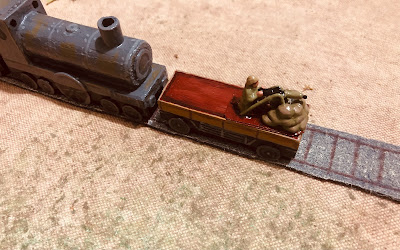The rules I am using for my WW1 Palestine Campaign games are a variation of One-Hour Wargames Machine Age rules by Neil Thomas which were the starting point. They have been modified in include a unit activation rule and to have cavalry charges. These are a draft variation and I have added a few notes on the variation choices after the rules.
 |
| An attack on a train in progress |
Unit Types
The game features the following units which need to be consistently based:
- Infantry
- Infantry with attached machine guns
- Cavalry
- Camel Corps
- Camel Corps with attached machine guns
- Artillery
- Tanks
- Armoured Cars
- Aircraft
Sequence of Play
Players take turns alternatively. During a player’s turn they follow a sequence of phases and attempt to activate their units:
- Movement
- Shooting
- Hand-to-Hand Combat
- Eliminating Units
Activation of Units
For units to move, shoot, charge, or continue hand-to-hand combat. They must successfully pass an activation check.
The procedure is: roll a D6 and multiply the score by 4. If the total is more than a unit’s hits, it can carry out the activity. Otherwise, the unit cannot carry out an action this turn.
 |
| Aircraft strafe infantry |
Movement
Successfully activated units may move up to the distances listed below during their movement turn:
- Infantry, Artillery, and Tanks - 6”
- Cavalry, Camelry, and Armoured Cars - 12”
Dismounting/Mounting - Cavalry and Camelry halve their move when dismounting or mounting. They cannot shoot unless dismounted.
Turning - Units turn by pivoting on their central point. They may turn at the start and/or the end of their move.
Interpenetration - Units may pass through other friendly units. However, units which are passed through must be inactive for the turn, no moving or shooting.
Terrain - Units are affected by terrain as follows:
- Towns - All units except for vehicles may end a move in a town. Unless they are on the road. Only infantry, camel corps and cavalry benefit from cover when positioned in a town.
- Difficult terrain - only infantry and dismounted unit may enter. All movement is 6”.
- Trenches - provide cover to infantry.
- Marsh/Lake - impassable.
- Wadis - Can be only crossed via bridges or agreed crossings.
- Hills - all units can move onto hills and artillery can shoot over other units if on the hill or firing at the hill.
- Roads - Units moving by road increase their movement distance by 3” if their entire move is spent on the road. The bonus cannot be used when charging.
Moving and Shooting - Units may not shoot if they have moved during the same turn.
Charges - Only cavalry (not Camel Corps) may charge by moving the unit into contact with the defending unit. The following restrictions apply:
- Turning - A charging unit may turn once, up to 45 degrees at the start of its move.
- Towns, Hills, and Difficult Terrain - Cavalry cannot charge units in towns and on hills.
- Fighting - Combat is resolved in the hand-to-hand combat phase.
 |
| Game in progress |
Shooting
For shooting the procedure is as follows:
Check the field of fire - Units may only shoot at a single unit within 45 degrees of their frontal facing, while units in town have a 360 degree facing.
Check the range - Measure the distance from the front centre of the shooting unit to any part of the target unit. Small arms have a range of 12” and artillery 48”
Artillery bombardment - Artillery units may only shoot at units that are not being attacked by small arms.
Determine casualties - To determine hits:
- Dismounted cavalry or camelry units roll a D3
- Infantry and artillery units roll a D6
- Infantry or camalry with supporting machine guns roll an additional D3 to add to their hits.
Check for cover - If the target is in cover, then halve the number of hits (round up fractions).
Note - Cavalry and Camel Corps units must be dismounted to shoot.
Hand-to-Hand Combat
Only cavalry units may charge into combat. However, once a unit is engaged it must activate for hand-to-hand combat. Tanks and Armoured Cars cannot be engaged in Hand-to-Hand combat.
The procedure is as follows:
One Sided Combat - Only the attacking unit inflicts hits.
Determine casualties - All units excluding Artillery roll a D6 for the number of hits. Halve hits if the defender is in trenches.
Movement within combat - Units remain in contact after combat until one side is eliminated. Units may turn to face an enemy unit unless already engage frontally.
Note - Machine guns and artillery may not be used in hand-to-hand combat.
Eliminating Units
Units are eliminated after taking 17 or more hits.
 |
| Train ready for trouble |
Notes on Vehicles
Tanks - A few were used in the Palestine campaign with limited success. The rules for using tanks:
- Halve all hits
- Shooting arc is 180 degrees and range 12” with D6 hits
- Movement is 6”
- Any failed activation checks and the tank is eliminated.
Armoured Cars - These were used quite successfully throughout the campaign being used in raids and supporting the Arab Rebellion. The rules for armoured cars:
- Halve all hits
- Shooting arc is 360 degrees and range 12” with D3 hits
- Movement is 12”
- Any failed activation checks and the armoured car is disabled.
Aircraft - Were successfully used throughout the campaign for reconnaissance, sighting for artillery, and bombing. The rules for aircraft:
Agree how many sorties can be performed in a game or roll a D3+2.
- During movement roll D6 and a sortie occurs with a 5+. Identify the unit being attacked by placing a counter or model aircraft next to it.
- If the aircraft is being used for spotting, the bombarding artillery unit (only one unit) can re-roll the hit D6, but must accept the second score.
- If the aircraft is being used for strafing and bombing. The aircraft can attack the enemy unit with D3 with no cover saves.
- Remove the markers or aircraft at the end of a player’s turn and not one sortie has been used.
General Notes
Artillery bombardment limitation - The limitation of artillery not being able to attack units being attacked by small arms (other units) is to reflect how artillery was used to soften up enemy positions prior to attacks by other units.
Activation - The conditions for troops in the Palestine campaign were harsh and supplies of water were as important as ammunition. The activation approach tries to show this by making activations more difficult for units that have accumulated hits.
Single Models - Artillery, tanks and armoured car units are vulnerable to early elimination after taking hits and failing an activation.
Cavalry Charges - The rules allow charges by cavalry. During the Palestine campaign there were occasions where cavalry were involved in successful charges. The Australian Light Horse at Beersheba being one of the better known charges.
Hits to Eliminate - All units were quite dispersed and in skirmish formations so rather than reduce the hits I opted to increase the hits required to eliminate a unit to 17.

















































